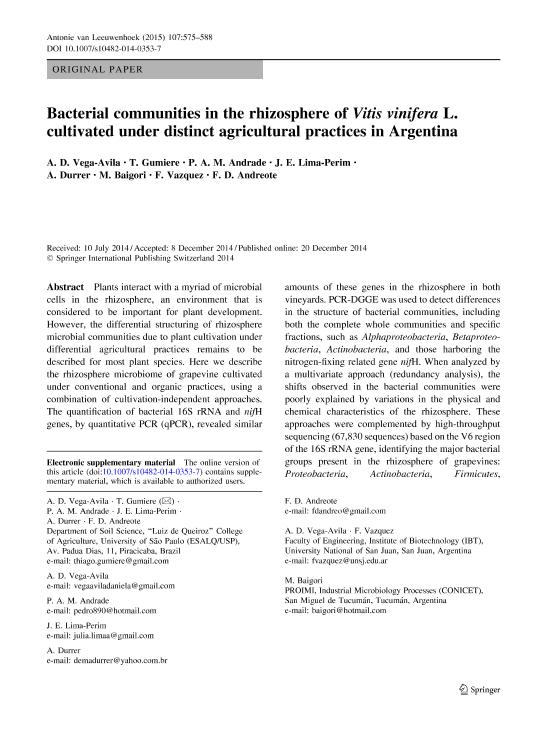Artículo
Bacterial communities in the rhizosphere of Vitis vinifera L. cultivated under distinct agricultural practices in Argentina
Vega Avila, Angela Daniela ; Gumiere, T.; Andrade, P. A. M.; Lima Perim, J. E.; Durrer, A.; Baigori, Mario Domingo
; Gumiere, T.; Andrade, P. A. M.; Lima Perim, J. E.; Durrer, A.; Baigori, Mario Domingo ; Vazquez, Fabio; Andreote, F. D.
; Vazquez, Fabio; Andreote, F. D.
 ; Gumiere, T.; Andrade, P. A. M.; Lima Perim, J. E.; Durrer, A.; Baigori, Mario Domingo
; Gumiere, T.; Andrade, P. A. M.; Lima Perim, J. E.; Durrer, A.; Baigori, Mario Domingo ; Vazquez, Fabio; Andreote, F. D.
; Vazquez, Fabio; Andreote, F. D.
Fecha de publicación:
02/2015
Editorial:
Springer
Revista:
Antonie van Leeuwenhoek
ISSN:
0003-6072
Idioma:
Inglés
Tipo de recurso:
Artículo publicado
Clasificación temática:
Resumen
Plants interact with a myriad of microbial cells in the rhizosphere, an environment that is considered to be important for plant development. However, the differential structuring of rhizosphere microbial communities due to plant cultivation under differential agricultural practices remains to be described for most plant species. Here we describe the rhizosphere microbiome of grapevine cultivated under conventional and organic practices, using a combination of cultivation-independent approaches. The quantification of bacterial 16S rRNA and nifH genes, by quantitative PCR (qPCR), revealed similar amounts of these genes in the rhizosphere in both vineyards. PCR-DGGE was used to detect differences in the structure of bacterial communities, including both the complete whole communities and specific fractions, such as Alphaproteobacteria, Betaproteobacteria, Actinobacteria, and those harboring the nitrogen-fixing related gene nifH. When analyzed by a multivariate approach (redundancy analysis), the shifts observed in the bacterial communities were poorly explained by variations in the physical and chemical characteristics of the rhizosphere. These approaches were complemented by high-throughput sequencing (67,830 sequences) based on the V6 region of the 16S rRNA gene, identifying the major bacterial groups present in the rhizosphere of grapevines: Proteobacteria, Actinobacteria, Firmicutes, Bacteriodetes, Acidobacteria, Cloroflexi, Verrucomicrobia and Planctomycetes, which occur in distinct proportions in the rhizosphere from each vineyard. The differences might be related to the selection of plant metabolism upon distinct reservoirs of microbial cells found in each vineyard. The results fill a gap in the knowledge of the rhizosphere of grapevines and also show distinctions in these bacterial communities due to agricultural practices.
Archivos asociados
Licencia
Identificadores
Colecciones
Articulos(PROIMI)
Articulos de PLANTA PILOTO DE PROC.IND.MICROBIOLOGICOS (I)
Articulos de PLANTA PILOTO DE PROC.IND.MICROBIOLOGICOS (I)
Citación
Vega Avila, Angela Daniela; Gumiere, T.; Andrade, P. A. M.; Lima Perim, J. E.; Durrer, A.; et al.; Bacterial communities in the rhizosphere of Vitis vinifera L. cultivated under distinct agricultural practices in Argentina; Springer; Antonie van Leeuwenhoek; 107; 2; 2-2015; 575-588
Compartir
Altmétricas



